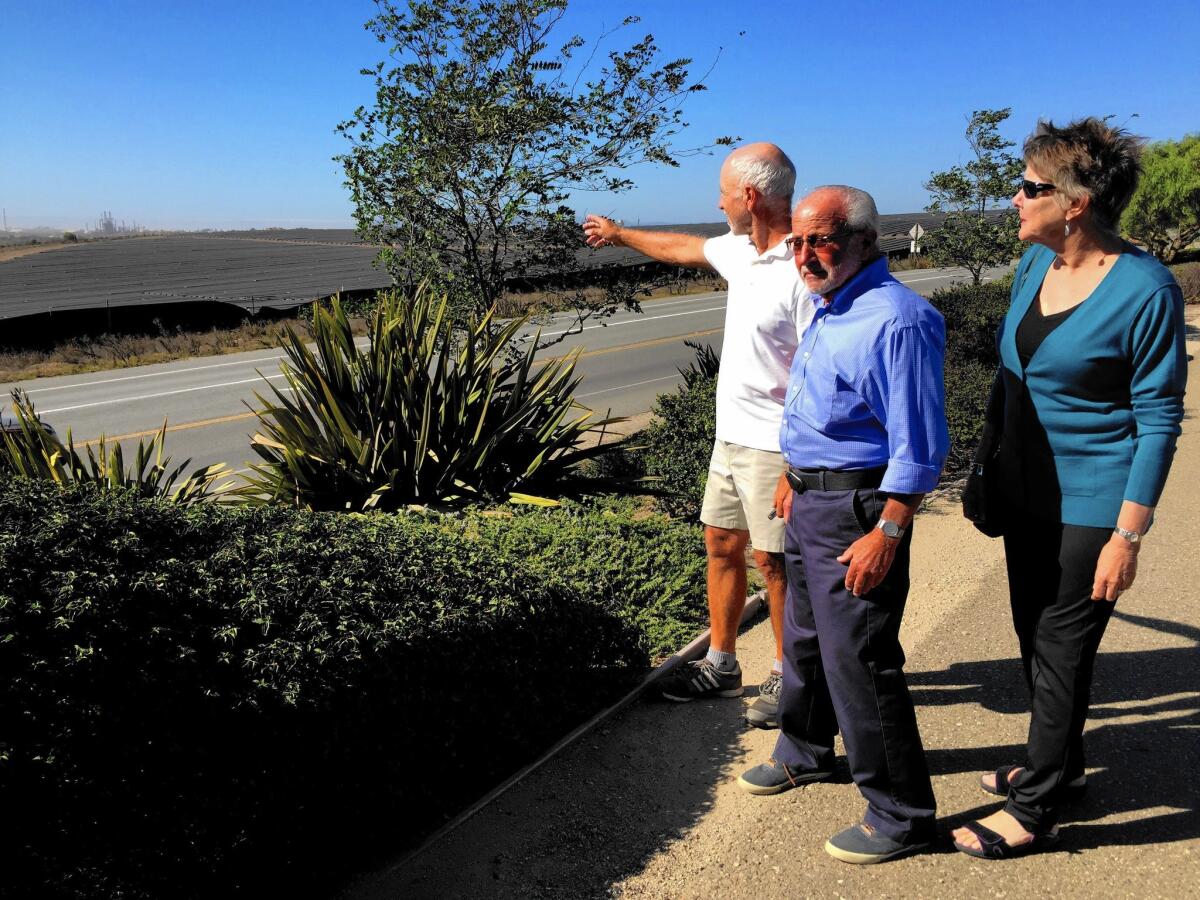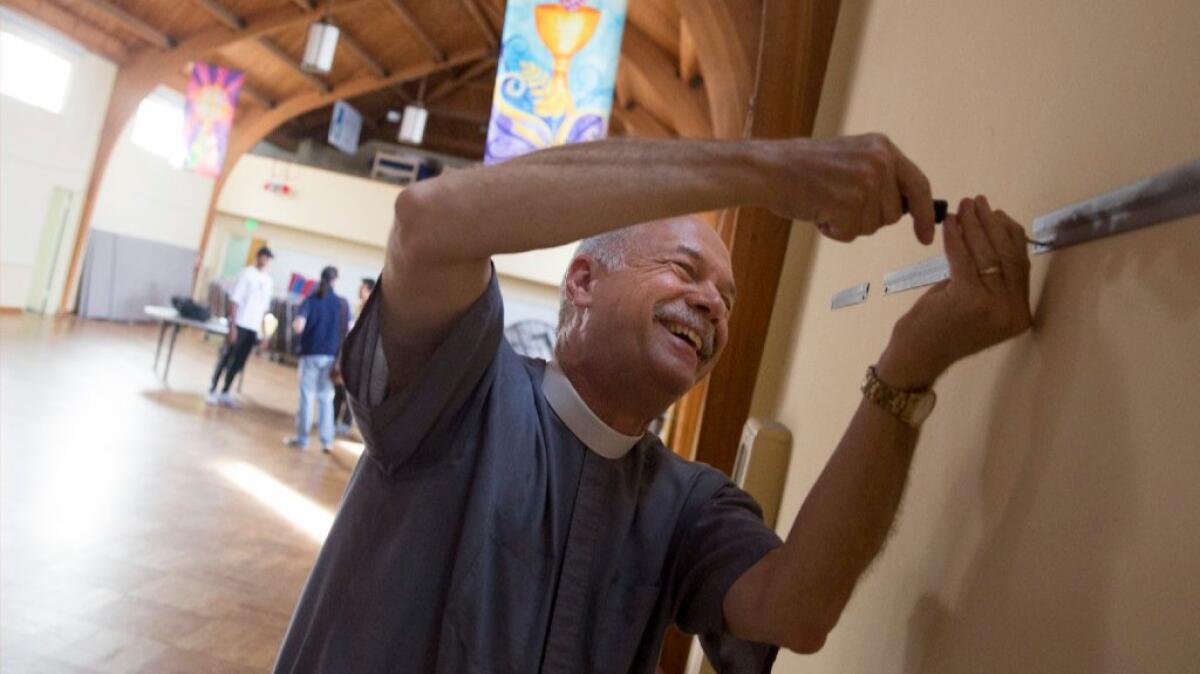Column: Postscripts that could renew your faith in public officials: Crude oil trains, Camarillo rock slides and homeless college students

- Share via
Who says the news is all bad?
Last week, after months of hearings and public protest, the San Luis Obispo County Planning Commission voted to deny oil giant Phillips 66 a permit to build a rail terminal at its Santa Maria Refinery. The project would have allowed Phillips to bring three milelong crude oil trains across California each week from as far away as Canada and Texas.
This was a considerable victory, and not just for the many retirees of nearby Nipomo Mesa, who would have been subjected to noise, nighttime lights and air pollution.
It was also a win for millions of Californians who live, work or study near Union Pacific railroad tracks, whose health and safety could be imperiled by oil trains, which have a faultless safety record. Except when they derail and explode. Which happens with increasing frequency.
I was alerted to this controversy a year ago, when a group of those aforementioned retirees, who had organized themselves as the Mesa Refinery Watch Group, invited me up to talk about the project.
These folks are smart, affluent, passionate, and, as I noted then, had plenty of time on their hands. They put that time to good use. They researched oil trains and engaged in a robust outreach effort, not just to media, but to communities up and down the state. They asked boards of supervisors, city councils, educators and others to oppose the project.
Dozens of letters poured in to the commission, including from every coastal board of supervisors from San Francisco to Los Angeles, representing millions of Californians. After an oil train derailed and exploded in Mosier, Ore., last summer, they brought the mayor of that tiny town to San Luis Obispo to talk about the calamity.
When the five-member Planning Commission took its final vote last week, the atmosphere in the room was tense.
Two commissioners were known to be in favor, two against. The fate of the terminal hung on Jim Irving, a real estate agent who had seemed to signal support for Phillips last spring. Commissioner Eric Meyer had offered a simple motion to deny the permit; Irving voted against it, which meant the hearings would continue. Irving received a torrent of abuse, but in the next months, commissioners imposed a tough set of conditions on the project.
Before casting his vote, Meyer gave a heartfelt speech about the clash between fossil fuels and the environment, and about the responsibility he felt, not just to his constituents, but to all Californians in the path of crude oil trains: “How can you say that the profit of one multinational corporation, and the supposed creation of 12 jobs outweigh the possibility of just one death, one burn victim, one person who loses their spouse or child?”
Irving went last. He acknowledged the tension in the room — “I know people out there are going to have a heart attack” — so after a moment of suspense, he got to the point. He could not approve the project.
Phillips, he told me, had not made a cogent case that it needed the oil, and he was worried about train safety. He was mindful that the tracks in Mosier had been inspected one week before the derailment, and irritated that Phillips and Union Pacific refused to share details about the integrity of railroad bridges and tracks.
Meyer told me later many people did not understand how clever Irving had been.
“He suffered four or five months of people saying to him, ‘What kind of an idiot are you for voting in favor of the project?’” said Meyer, recalling last May’s nonbinding straw vote. “He is not an idiot. He is brilliant. This move was sophisticated on his part, and has allowed us as a Planning Commission to simultaneously deny the project and craft conditions that will follow the project should the board of supervisors overturn our denial on an appeal.”
As for the Nipomo Mesa residents, they were elated.
“For three years, we’ve all bumped into people who say, ‘Are you kidding? You’re going to fight Phillips 66? They’re a $4.2-billion company,’” said Martin Akel, a Mesa Refinery Watch Group stalwart. “‘They have such deep pockets and you don’t have any pockets.’ We said, ‘We’ll beat them with people power.’ And that’s what we did.”
We’ve all bumped into people who say, ‘You’re going to fight Phillips 66?’ We said, ‘We’ll beat them with people power.’ And that’s what we did.
— Martin Akel, co-founder of the Mesa Refinery Watch Group
::

Last month, I brought you the tale of the crumbling mountain in Camarillo Springs.
Residents were in a tangle with Camarillo officials over who should take responsibility for maintaining barriers and drains installed by the city on Conejo Mountain last year after a devastating 2013 wildfire led to catastrophic rock- and mudslides in 2014.
City officials had set aside money to clean out the debris basins, which are partially full from last season’s storms, but refused to spend the money until the homeowners associations and the private parties who own the mountain come up with a plan to maintain the system.
Residents, who were getting nervous about the approaching rainy season, say they can’t afford to do that. Anyway, they say, last year they collaborated with the mountain’s owners and came up with what they felt was a good plan to keep the mountain at bay. It would have cost them about $40,000 a year. But the Camarillo City Council rejected it, and instead put up its own system of drain channels and debris barriers, which will be much more expensive to maintain.
On Sept. 28, two weeks after I wrote about the clash, the Camarillo City Council voted unanimously to spend $200,000 to empty the debris basins.
“We got our immediate problem taken care of for this year,” said Pete Faxon, president of the Camarillo Springs Homeowners Assn., “but they have let us know they are not going to do it again. I’m not sure what will happen if we have severe storms. But it’s not our mountain, and those are not our rocks.”
::
Three weeks ago, I wrote about Bruin Shelter, believed to be the first homeless shelter for college students, run by college students.

Nine students from Santa Monica College and UCLA were scheduled to move into a former choir loft at Mt. Olive Lutheran Church in Santa Monica on Oct. 2. Unfortunately, the shelter got snarled in red tape after Santa Monica officials said it violated health and safety codes. The staircase to the loft was too narrow, and there was concern about a lack of showers.
Happily, a compromise has been reached, Mt. Olive Pastor Eric Shafer said Monday. The beds have been moved to a couple of ground-floor rooms, and the shelter is due to open soon. The shower issue is still unresolved, but the city is committed to helping get the shelter open, said Danielle Noble, Santa Monica’s deputy city manager.
“The city is working with us,” Shafer said. “They are being very cooperative.”
If you want to show Bruin Shelter some love, Mt. Olive is hosting a jazz and classical concert Friday at 8 p.m. Donations will be taken at the door.
Twitter: @AbcarianLAT
More to Read
Sign up for Essential California
The most important California stories and recommendations in your inbox every morning.
You may occasionally receive promotional content from the Los Angeles Times.














